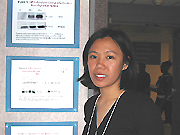
| T H E N I H C A T A L Y S T | M A Y – J U N E 2003 |
|
|
|
THE RITES OF SPRING:POSTBAC POSTER DAY |
by Nicole Kresge and Fran Pollner |
More than 150 postbaccalaureate trainees displayed and discoursed upon the nature and meaning of their NIH research at the fourth annual Postbac Poster Day, May 7.
Postbacs are recent college graduates with an aptitude for and inclination toward biomedical research who were selected to spend a year or two in training at NIH to find out if the life of a research scientist actually suits them. The great majority apply to (and are accepted into) a Ph.D. program and/or medical school during their stay at NIH.
 |
|
Emilyn
Alejandro
|
Emilyn
Alejandro, University of Washington, Seattle: Granulin-Epithelial Precursor
(GEP): A New Molecular Target in Ovarian Cancer.
Preceptor:
Elise Kohn,
NCI Laboratory of Pathology
It was recently discovered that granulin-epithelin precursor (GEP) is upregulated in invasive ovarian cancer, a finding revealed via cDNA library comparison of microdissected ovarian tumors with low malignant potential and invasive ovarian tumors. Alejandro's research focused on learning about the regulation of GEP expression by characterizing its signaling pathways.
Alejandro found that GEP is expressed in the HEY-A8 ovarian tumor cell line. She also found that lysophosphatidic acid, an ovarian cancer growth factor, stimulates GEP production in HEY-A8 cells in a dose- and time-dependent manner. In the future, she hopes to determine the biological function of GEP and to transform GEP as a molecular target for the treatment of epithelial ovarian cancer. —N.K.
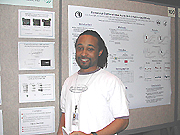 |
|
Brent
Elliott
|
Brent
Elliott, George Mason University, Fairfax, Va.: Gamma Secretase: The
Role of Nicastrin and Presenilin.
Preceptors:
Alan Kimmel
and Lisa Kreppel,
NIDDK Laboratory
of Cellular and Developmental Biology
Nicastrin (NCT) and presenilin (PS) are two components of the enzymatic complex g-secretase, which processes b-amyloid precursor protein and others. Defects in g-secretase are linked to Alzheimer's disease. To investigate the biological role of g-secretase, Elliot and his coworkers knocked out NCT and PS in the slime mold Dictyostelium. The resulting mutants experienced delays in development, suggesting that g-secretase plays a developmental role. In the future, the laboratory hopes to knock out the other known components of g-secretase—PEN-2 and APH-1—make rescue vectors and GFP fusion proteins, and determine whether there are other unknown components of g-secretase.—N.K.
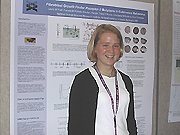 |
|
Laura
Yudt
|
Laura
Yudt, Gustavus Adolphus College, St. Peter, Minn.: Mutations in a Growth
Factor Receptor Tyrosine Kinase in Cutaneous Melanoma.
Preceptor:
Paul Meltzer, NHGRI Cancer
Genetics Branch
The ligand to a growth factor receptor tyrosine ki nase is highly overexpressed in melanoma cell lines compared with normal melanocytes, leading to the speculation that a mutation in the receptor increases its affinity for the ligand, with accompanying effects on such cell functions as cell division and angiogenesis, Yudt said.
She and her colleagues found mutations in 5 of 47 melanoma cell lines—"not a phenomenal percentage, but the mutations occur in highly conserved residues," she said. The next step is to explore at the protein level the mutations’ effect on function. Constitutive action through phosphorylation, Yudt noted, would be a key finding. —F.P.
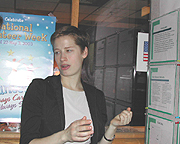 |
|
Erica
Westly
|
Erica
Westly, Marlboro College, Marlboro, Vt.: Linkage-based Study of GABA
Receptor Gene Clusters at Chromosome 4 and Alcoholism in Two Populations.
Preceptors:
David Goldman
and Ke Xu, NIAAA
Laboratory
of Neurogenetics
Whole genome linkage scans have implicated the chromosome 4 cluster of GABA receptor genes in vulnerability to alcoholism, so now these investigators are using the multilocus haplotype linkage approach to close in on the location of the effective locus.
The NIAAA team looked for linkage disequilibrium among 27 polymorphisms from chromosome 4, comparing findings in more than 1,200 probands, family members, and controls in two populations, one Finnish and the other Southwest American Indian. The team was blind to the phenotypic diagnosis. "We’re still analyzing the data," Westly said.
Determination of whether particular linkages are functional or not will fall to another research team, "who will look at the molecular biology of the proteins for correlations with alcoholism," Westly said. —F.P.
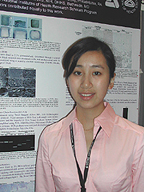 |
|
Xiaoxue
Huang
|
Xiaoxue
Huang, University of Maryland, Baltimore: A Tissue Engineered Osteochondral
Construct Based on Human Mesenchymal Stem Cells: Potential Application for Articular
Cartilage Repair.
Preceptors:
Rocky
Tuan, David
Hall, and Richard
Tuli, NIAMS Cartilage
Biology Branch
A tissue-engineered osteochondral plug constructed using autologous mesenchymal stem cells displayed tissue morphology similar to that of native cartilage and subchondral bone in a study that could eventually have dramatic implications for the treatment of diseases such as osteoarthritis, which affects more than 90 percent of the population over 40.
Mesenchymal stem cells derived from human trabecular bone and grown in culture can differentiate into cartilage, bone, and fat cells, Huang said. Using a patient’s own mesenchymal stem cells minimizes the risk of immunologic rejection and infectious disease transmission. Such a cartilage-and-bone construct may eventually serve as a therapeutic substitute for total knee and hip replacement surgery.
Once the laboratory model is optimized, the research will move toward the clinical arena. —F.P.
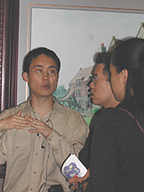 |
|
Antony
Hsu
|
Antony
Hsu, New York University School of Medicine, New York City: Bone Marrow
Stem Cells.
Preceptors:
Ronald McKay and
Florian Then Bergh,
NINDS Laboratory of Molecular Biology
Bone marrow stem cells (BMSCs) can potentially offer a renewable, easily accessible, noncontroversial source of pluripotent stem cells. It is hoped that transplanted BMSCs will integrate and function as normal differentiated cells in the treatment of neurodegenerative disorders.
Hsu’s research centers on manipulating the in vitro environment to encourage neuronal differentiation and integration. He attempted to co-culture rat hippocampal neurons with rat BMSCs and found that astrocytes, but not neurons, grew among the BMSCs. He also cultured mouse BMSCs and treated them with basic fibroblast growth factor. Immunostaining demonstrated that neuron-specific proteins were present inside the cells.
Hsu plans to obtain functional data from the differentiated mouse cells to prove they are indeed neurons.—N.K.
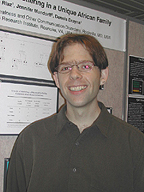 |
|
Bailey
Levis
|
Bailey
Levis, St. Mary’s College of California, Moraga, Calif.: Genetic
Studies of Stuttering in a Unique African Family.
Preceptor:
Dennis Drayna,
NIDCD Laboratory of Moledular Genetics
There are more than three million Americans who stutter, a speech disorder for which there are no cures today. Drugs, speech therapy, and medical devices aimed at reducing stuttering are not always successful.
Levis, a mild stutterer himself, is interested in finding the genetic causes of stuttering, which are known to exist. He and his colleagues analyzed both the speech and DNA samples collected from a 100-member African family, 45 of whom stutter. He is using PCR and gel electrophoresis to genotype the family members. Once the genotyping is completed, he will use computer programs to determine regions of the genome showing a linkage to stuttering.
Finally, homing in on the responsible gene(s) could shed light on the causes of and best approaches to curing this enigmatic disorder, Levis said. —N.K.
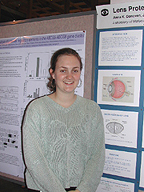 |
|
Anna
Donovan
|
Anna
K. Donovan, Grinnell College, Grinnell, Iowa: Proteins Interacting with
Lens MIP (Major Intrinsic Protein)/Aquaporin 0.
Preceptor:
Ana B. Chepelinsky,
NEI Laboratory of Molecular
and Developmental Biology
The aim of this research was to elucidate the function of MIP, a protein found in the lens fiber cell membranes that plays a role in ocular lens transparency and, when mutated, is associated with genetic cataracts.
A yeast two-hybrid screening and confirmatory assays established that MIP interacts within the lens with the gE-crystallin protein and could therefore be involved in lens structure organization, Donovan said.
She characterized the study as a basic research project that will provide insights into the mechanisms of genetic cataracts.—F.P.
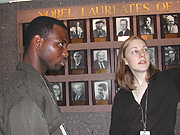 |
|
Amy
Seitz discusses her poster with Collins Karikari
|
Amy
Seitz, University of Maryland, Baltimore: Sand Fly Saliva as a Leishmaniasis
Vaccine?
Preceptor:
Jesus Valenzuela,
NIAID Laboratory of Malaria and Vector Research
(Also shown is postbac Collins
Karikari, Morgan State University, Baltimore, Md., a labmate who presented
his own poster on Developmental Regulation of Necrotic-like Serpin in Human
Malaria Vector, Anopheles gambiae. Karikari’s preceptors are Mohammed
Shahabuddin and Xinzhuan
Su)
Seitz and her colleagues are using saliva from sand flies to design and synthesize a DNA vaccine for Leishmania. Sand flies often carry the Leishmania parasite, and their saliva exacerbates infection. However, in humans, exposure to sand fly saliva has been found to correlate with increased resistance to the parasite.
Seitz determined the protein content of salivary gland homogenate from sand flies and expressed some of the proteins in the T7NT vector. She then confirmed that mice exposed to salivary homogenate contained antibodies to the proteins.
Next, Seitz hopes not only to use the DNA from these proteins to make a vaccine, but also to analyze salivary homogenates from other species of sand fly.—N.K.
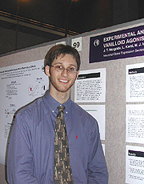 |
|
Joseph
Nezgoda
|
Joseph
Nezgoda, Georgetown University, Washington, D.C.: Experimental Analgesic
Actions of Vanilloid Agonists.
Preceptor:
Mike Iadarola,
NIDCR Pain and Neurosensory
Mechanisms Branch
Nezgoda and his colleagues
are trying to make a neuron-killing pain reliever for people experiencing great
discomfort, such as end-stage cancer patients. A species of Moroccan cactus
contains a compound called RTX, which binds to the vanilloid pain receptor known
as VRI. When administered in high enough amounts, RTX can selectively kill these
pain-signaling neurons.
Nezgoda injected
a single dose of RTX into the spinal cords of rats and tested their pain responses
over the next 18 weeks. He found that low doses of RTX affected only the hind
paws, indicating a localized effect. Surprisingly, high doses of RTX numbed
sensation in the hind paws, front paws, and corneas, indicating a general analgesic
effect. At all dose levels, there was no apparent toxic effect on the rats.
To complete his analysis, Nezgoda plans on doing a histological analysis of the animals to confirm nerve cell death. He hopes that RTX will eventually be tested in clinical trials. —N.K.
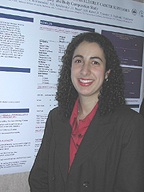 |
|
Juliessa
Pavon
|
Juliessa
Pavon, Duke University, Durham, N.C.: The Development of Functional Limitations
in Elderly Short- and Long-Term Cancer Survivors.
Preceptors:
Tamara Harris
and Lisa Colbert, NIA Laboratory
of Epidemiology, Demography, and Biometry
Given that you survive cancer and come through in good health, does having cancer influence risk for developing a functional limitation? One of the first longitudinal studies to examine this question and look at the risk of functional disability in elderly cancer survivors has amassed results that suggest that being a cancer survivor—at least in the short term of under five years—confers an advantage not evident in elderly people who have not had cancer.
Short-term cancer survivors, aged 70 to 79, were at less risk of developing functional limitation than similarly aged controls who had not had cancer. Functional limitation was defined as difficulty walking a quarter-mile or climbing ten steps. Among cancer survivors of greater than five years, however, men were at greater risk than their noncancer counterparts, and there were no differences among the women.
The study was part of the Health, Aging, and Body Composition Study, which was begun in 1997 and is ongoing. More research is needed, Pavon said, to understand the mediating effects within those first five years and to correlate stage of cancer at diagnosis as well as treatment with long-term developments. —F.P.